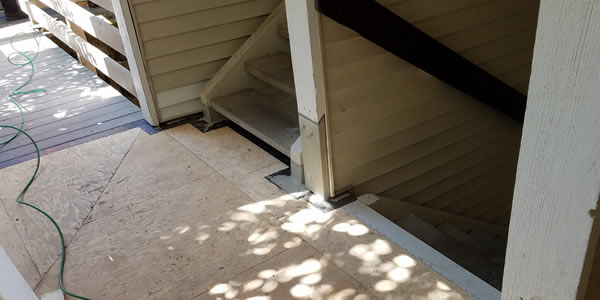Stairs & Landings
The most common type of stairs we work on have wood stringers with either concrete or wood treads.
When stairs and handrails are replaced in commercial or multi-family buildings they are subject to requirements listed in the International Building Code. The code requirements are complex and must be rigorously followed to ensure code compliance.
We frequently replace or repair stairs and landings as part of our projects. This requires us to plan the construction sequence so that at the end of the day, the residents can safely access their units.
This usually means that removing and replacing stairs takes longer than if we were just removing and replacing stairs in an unoccupied building.
After repairing or replacing the stairs, we have to ensure that the stairs do not rot again.
To do that, we install the proper sheet metal saddles and flashings required for water protection, as well as installing any waterproofing needed.
Examples of the Code
Stairway Width – depends on occupancy load. Occupant loads greater than 50 require a width of 44"; a 36" width is sufficient for occupant loads under 50.
Treads and Risers – treads must be at least 11" deep. Riser height can vary between 4" and 7".
Dimensional Uniformity – Stair treads and risers must be of uniform size and shape. The tolerance between the largest and smallest riser height or between the largest and smallest tread depth shall not exceed 0.375 inch (3/8") in any flight of stairs.
Landings – must be at least as deep as the stairs are wide. Where a door opens into the landing, it can't project more than 7" into the required depth of the landing.
Flights – are limited to a vertical height of 12'.
Handrails – must be mounted between 34" and 38" above the tread nosings and landings. Handrails need to extend 12" past thee top riser and one tread depth past the bottom riser or one tread depth plus 12" if ADA.
Handrail Shape and Mounting – If circular, they need to be 1.25″ to 2″ in diameter. If the handrail isn't circular it needs to have a perimeter between 4″ and 6.25″ with a maximum cross section of 2.25″. The handrail needs to be mounted a minimum of 1.5" off the wall.
Head Height – must be at least 80" measured off the tread nosings and it needs to be maintained for one additional riser depth at the bottom of the stairs.

Let Us Be The Solution For Your Next Project
Get a no-obligation site assessment
